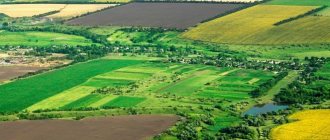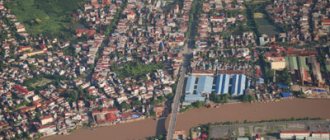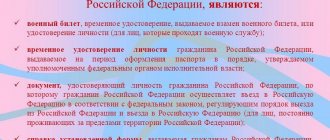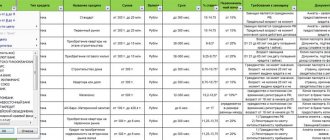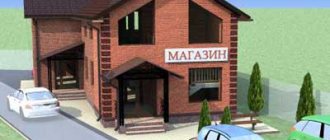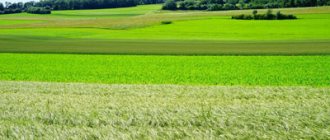Pravozhil.com > Real estate registration > Land registration > Land fund - what is it?
The life of any person is inextricably linked with the earth. However, one thinks about what a land fund is and the legal aspects of land legal relations only when the question arises of acquiring a plot of land for construction or other needs.
This natural object has unique properties and is subject to a special regulatory regime. In order to understand these nuances, you first need to get an idea of the land fund: what is it and how is it used?
The concept of the composition of Russian lands
The phrase “land composition” is used in the title of Article 7 of the Land Code of the Russian Federation. We are talking here about dividing them into categories according to their intended purpose. It is noteworthy that in the text of the article under consideration and further, within Chapter I of the Land Code of the Russian Federation “General Provisions,” the composition of lands is no longer mentioned. Other chapters of the Code use concepts that are narrower in content, for example, “composition of reserve lands.”
There is no legal definition of the composition of lands in the legislation. It is usually interpreted as a set of indicators of the ratio of lands according to their condition and acceptable methods of use.
Land categories
The institution of dividing land according to its intended purpose is traditional for the domestic legal system. The modern Land Code has retained all seven categories that existed in the similar code of the RSFSR. The names of some of them have undergone some changes, but the content and legal regime have remained the same.
The basis for the distribution of lands into categories is their purpose.
Land category is a more general term. The intended purpose is narrower. If we are talking about agricultural land, then such land can be used both for personal farming and for gardening. In this case, when the intended purpose changes, the category (agricultural land) does not change.
The legislator obliges landowners, land users and tenants to use their plots in accordance with their intended purpose, belonging to the corresponding category of land. Regulation of the conditions for the use of lands of different categories is determined by the content of Chapters XV-XVIII of the Land Code of the Russian Federation.
Belonging to a category is the basis of the legal regime of each site. The division of land is a kind of zoning of the territory of Russia, which is of fundamental importance for calculating the resources of all sectors of the national economy. Any plot must be classified as a specific category of land. This parameter is specified in each of the following documents:
- civil contract, the subject of which is the plot;
- an individual legal act of a municipality or other government agency on the provision of a site for ownership, lease, or temporary use;
- extracts from the land state cadastre, USRN.
How to find out the characteristics of land plots for each VRI
- In accordance with paragraph 3 of part 11.2 of the Land Code of the Russian Federation, the intended purpose and permitted use of the formed land plots are recognized as the intended purpose and permitted use of land plots from which, during division, merger, redistribution or allocation, land plots are formed, except for cases established by federal laws.
- At the same time, according to paragraph 3 of Article 85 of the Land Code of the Russian Federation, urban planning regulations are mandatory for all owners of land plots, land users, landowners and tenants of land plots, regardless of the form of ownership and other rights to land plots. These persons may use land plots in accordance with any type of permitted use provided for by the town planning regulations for each territorial zone.
- Part 8 of Article 36 of the Town Planning Code of the Russian Federation and part 4 of Article 85 of the Land Code of the Russian Federation establishes that land plots or capital construction projects, types of permitted use, maximum (minimum and (or) maximum) sizes and limit parameters of which do not comply with town planning regulations, may be used without setting a deadline for bringing them into compliance with urban planning regulations, except in cases where the use of such land plots and capital construction projects is dangerous to human life or health, to the environment, or cultural heritage sites.
- In accordance with paragraph 70 of the Procedure for maintaining the state real estate cadastre, approved by order of the Ministry of Economic Development of Russia dated 02/04/2010 N 42 (hereinafter referred to as the Procedure), information on the types of permitted use of a land plot is entered into the register of real estate on the basis of urban planning regulations or on the basis of an act of a government authority or local government authority. If the formation of land plots is not associated with a change in the type of permitted use of the original land plot, the type of permitted use of the resulting land plots in the register of real estate must correspond to the type of permitted use of the original land plot.
- According to paragraph 52 of the Requirements for the preparation of a boundary plan, approved by Order of the Ministry of Economic Development of Russia dated November 24, 2008 N 412 (hereinafter referred to as the Requirements), the type of permitted use of the resulting land plots must correspond to the information of the state real estate cadastre on the type of permitted use of the original land plot, except for cases established legislation of the Russian Federation. In such cases, the type of permitted use of the land plot(s) being formed is indicated in detail “4” of the section “Information on the land plots being formed and their parts” if there is a free-form declaration of the interested party on the selected type of permitted use of the land plot, drawn up on the basis of the town planning regulations, or if there is an act of a state authority or local government determining the type of permitted use of the land plot being formed (a declaration or a copy of the act, according to which information about the type of permitted use of the land plot is included in the boundary plan, is included in the Appendix to the boundary plan).
- Paragraphs 6 - 7 of Article 11.9 of the Land Code of the Russian Federation provide that the formation of land plots should not lead to wedging, interspersing, broken boundaries, interstriations, the impossibility of placing real estate objects and other shortcomings that impede the rational use and protection of land, as well as violate the requirements established by this Code , other federal laws. The formation of a land plot, the boundaries of which cross the boundaries of territorial zones, forest districts, forest parks, is not allowed, with the exception of a land plot formed for carrying out work on geological exploration of subsoil, development of mineral deposits, placement of linear objects, hydraulic structures, as well as reservoirs and other artificial water bodies. objects.
Based on the rules set out above, we can conclude that when establishing the type of permitted use of the land plot being formed, it is necessary to take into account the purpose of its formation, rationality of use, as well as the presence of legislative acts establishing exceptions to the provisions of paragraph 3 of part 11.2 of the Land Code of the Russian Federation.
Thus, the basic requirements for the formation of land plots are enshrined in the Land Code of the Russian Federation, the basic requirements for the establishment of certain VRI on the territory are contained in the PZZ of your region. For example, the characteristics of land plots for private plots are enshrined in the Federal Law “On the turnover of agricultural land” and in your regional law on the turnover of agricultural land.
At the same time, any decision of a government body or official can be challenged in court. Only an appropriate examination can establish the exact possibility that a particular land belongs to the required VRI.
Agricultural land
First of all, agricultural land is a strategic object of social life, the basis for the economic and environmental well-being of the state as a whole and each region separately. They are located outside the settlements and are intended for running individual subsidiary plots or growing and processing agricultural products on an industrial scale.
Regulation of the legal status of agricultural land in Russia is ensured with the help of Chapter XIV of the Land Code of the Russian Federation and thematic Federal Law No. 101, dedicated to the turnover of the type of land in question. The characteristics of agricultural land are associated with the ability to generate agricultural products. Unlike industrial lands, which are only a spatial basis for economic management, agricultural lands are a key means and an indispensable condition for agricultural production. This category of land includes:
- agricultural land, including arable land, pastures, hayfields;
- areas where closed reservoirs, on-farm communications and paths, and protective plantings are located;
- areas occupied by agricultural buildings.
One of the principles of land, natural resources and environmental legislation recognizes the priority of agricultural land. Fertile agricultural lands are used mainly for the development of arable lands, gardens and other perennial plantings.
Distribution of land by category
The latest information on the distribution of land in the country's land fund into categories is published on the website of Rosreestr (Federal Service for State Registration, Cadastre and Cartography). At the time of writing, data is available on the state and use of land in the Russian Federation as of January 1, 2014.
Before moving on to the analysis of digital material, I would like to note the following feature. Land registration in the Russian Federation, in accordance with the legislation and established traditions, is carried out by categories of land and land. Land as lands that are systematically used or suitable for use for specific economic purposes and differ in natural and historical characteristics [1], along with categories of land and VRI, are another way to systematize a huge amount of data on the availability and use of the country’s land fund.
Land is divided into agricultural and non-agricultural. Agricultural land is land that is systematically used to produce agricultural products. These include: arable land, perennial plantings, fallow lands, hayfields, pastures. Non-agricultural land includes forest areas, forest plantations, lands under water, building lands, swamps, lands under roads, disturbed lands and other lands.
Figure 1. Structure of the land fund of the Russian Federation by land category (as of January 1, 2014)
The largest part of the country's land fund, which includes 1709.8 million hectares of land, is made up of forest lands - 1122.3 million hectares (65.6% of all lands) and agricultural lands - 386.5 million hectares (22.6 %). The lands of populated areas make up only 1.2% of all lands of the Russian Federation. Their total area is 20.0 million hectares. We were interested in comparing the structure of the land fund in the country as a whole and the structure of the land fund in the Central Federal District, in the Moscow region, as well as in the Tver region, which has recently become an increasingly attractive area for investing in land.
Figure 2. Structure of the land fund of the Central Federal District by land category (as of January 1, 2014)
In the land structure of the Central Federal District (total area 65.0 million hectares), agricultural lands and forest lands have changed places compared to the structure in the country as a whole. Agricultural lands in the Central Federal District amount to 35.2 million hectares (54.2%), forest lands - 20.9 million hectares (32.1%). In the Central Federal District, the share of land in settlements is significantly greater than in the country as a whole - 7.5%.
Figure 3. Structure of the Moscow region’s land fund by land category (as of January 1, 2014)
In the Moscow region, in the structure of lands with a total area of 4.4 million hectares, the first three places were distributed as follows:
1) Forest fund lands – 1.8 million hectares (40.03%); 2) Agricultural lands – 1.7 million hectares (37.6%); 3) Lands of populated areas – 0.5 million hectares (12.2%).
Figure 4. Structure of the land fund of the Tver region by land category (as of January 1, 2014)
The land fund of the Tver region is almost twice as large as the land fund of the Moscow region. The total land area of the Tver region is 8.4 million hectares. The structure of the land fund of the Tver region by land category is generally similar to the structure of land in the country as a whole. The first place is occupied by forest lands - 4.8 million hectares (57.4%), second - agricultural lands - 2.6 million hectares (30.6%), third - lands of populated areas - 0.4 million. ha (4.8%).
Lands of settlements
Regulation of the legal status of the type of land in question is ensured by Chapter XV of the Land Code of the Russian Federation. The lands of populated areas serve as a territorial base for the construction and reconstruction of various structures, as well as their complexes.
The lands of settlements are under the jurisdiction of councils of deputies of municipalities. The procedure for developing promising lands in rural settlements is established by planning and development projects; unpromising - by the rules of on-farm land management. Their features are determined by their location within the city limits.
The lands of settlements are used for the development of settlements, placement of residential, social, cultural and industrial buildings. The lands of settlements are separated from other types of lands by the boundaries of the corresponding settlements.
Fund management system
A separate sphere of public administration is the management of the land fund of the Russian Federation. The area of his authority is land in the broad sense of the word.
The subject of legal regulation is the system of legal relations in the field of protection and rational use of land resources as an object of economic management.
The management bodies of the land fund of the Russian Federation are united into an integral system.
Depending on the powers received by these structures, a division into bodies of general and special competence is provided.
The former carry out general management and regulate all land-legal relations existing in the state. The latter are vested with a limited range of powers in the management of the land fund and perform public administration functions that relate to a specific area of coordination: maintaining the state land cadastre, monitoring, land management and others.
The first group includes government bodies of the Russian Federation:
- President and heads of constituent entities;
- Federal Assembly and legislative assemblies of constituent entities;
- Government and constituent authorities;
- local government bodies.
Bodies of special competence included in the second group are determined by the Decree of the President of the Russian Federation and include ministries, federal services and agencies.
State management of the land fund in 2021 is carried out at several levels:
- federal (territory of the entire state);
- subjects of the Russian Federation: lands within the republic, territory, region, autonomous regions and districts, cities of federal significance;
- municipalities: land resources of districts, cities, other settlements.
Lands of industry, energy, transport
Chapter XVI of the Land Code of the Russian Federation establishes the legal regime of industrial and transport lands. A large number of enterprises in different spheres of the national economy are concentrated in areas of this category.
For this reason, industrial, energy, transport, communications, radio broadcasting lands more than others need additional regulation in the form of zoning. The legislator specifically regulates the types of permitted use of lands of individual subcategories (communications, energy, defense).
The specific legal regime of industrial lands has been established with the aim of creating appropriate conditions for:
- operation of equipment and entire complexes of industrial enterprises;
- ensuring technical, nuclear, sanitary well-being.
What happens if you use the land for other purposes?
The legal regime is a system of prohibitions, restrictions, permissions and obligations. Owners of agricultural land are obliged to:
- use the land in accordance with its intended purpose and permitted use;
- take measures to prevent any impacts on the land plot that could lead to significant losses of fertility and other significant properties;
- maintain the optimal condition of reclaimed lands;
Owners of agricultural land have the right:
- acquire, sell, donate, inherit land belonging to them;
- receive from the state free of charge or on a paid basis lands of this category for ownership or use;
- submit a petition to change the status, category and permitted use of land.
The main restrictions and prohibitions can be summarized as follows:
- Non-use of agricultural land is prohibited. This requirement applies to any plots owned by individuals and legal entities. Only the state that owns the lands of GosZemZapas and reserve areas can not use the land;
- Foreign citizens cannot participate in the turnover of agricultural land. However, they can lease land and use it for its intended purpose, fulfilling all responsibilities for maintaining the plots in proper condition;
- Arbitrary transfer of agricultural land to another category or permitted use is prohibited and punishable;
- There are restrictions on the duration and content of the lease. The law determines the maximum and minimum terms, as well as the regime for using land plots;
- During territorial zoning, particularly valuable land plots that are withdrawn from circulation are determined. They are on the list of territories prohibited from privatization. Disturbed lands are also withdrawn from circulation and transferred to fallow until fertility and other significant properties are restored.
Please note that failure to perform or improper performance of duties entails penalties provided for by law in the form of fines, criminal liability and other measures, including financial liability of a compensatory nature.
I am ready to advise you free of charge by phone (24 hours a day, 7 days a week)
The call is free for all regions of the Russian Federation
In the summer of 2021, the procedure for confiscating land that is not used at all or with any violations was simplified. According to the Ministry of Agriculture, after the introduction of these amendments, more than 120 thousand hectares of land were returned to circulation.
Lands of specially protected territories and objects
Regulation of the position of this category of land is provided by Chapter XVII of the Land Code of the Russian Federation. Lands of specially protected territories and objects have special value due to specific properties: aesthetic, health, natural. They may also have cultural, recreational, scientific or historical value.
Lands of specially protected territories and objects are often removed from the cycle of ordinary economic activity. The types of permitted use of this type of land are strictly limited so as not to destroy their valuable properties.
Forest fund lands
The legal regime of forest fund lands is determined by the needs of forest protection, afforestation and logging. The concept and composition of forest fund lands are regulated by Chapter XVII of the Land Code of the Russian Federation. The Forest Code links the concepts of “forest fund lands” and “forest fund”. The latter is formed by:
- natural and planted forests, except for those located on defense lands and settlement lands;
- unforested forest lands.
Unforested forest lands include:
- areas set aside for forest restoration after fires and deforestation;
- areas intended for the needs of forestry and actually occupied by buildings, agricultural land, roads and the like;
- swamps, rocky areas, and other areas unsuitable for afforestation.
The legal regime of forest fund lands is determined by the regime of natural objects located on them. The protection regime for forests of the first group is the most strict, and the least for forests of the third. The inclusion of individual areas in the forest fund lands or their removal from the category under consideration is carried out taking into account the requirements of the Forest Code of Russia.
Land fund - what is it? The legislative framework
What is the land fund of the Russian Federation?
What is meant by the country's land fund? The entire earth's surface located within the country's borders is of interest not only from a geographical point of view. It establishes the boundaries of the state, is a valuable resource, and ensures the livelihoods of every person.
The regulation of any relationship in the land sphere is built by the state on the principles of protecting this valuable object and the rationality of its use.
The earth's surface is understood not only as a part of nature, but also of civil relations. The totality of all the lands of the country forms its single fund. Individual owners can use it in certain areas.
For the purpose of more efficient, intelligent use and protection of lands, they are given a special status. The main document regulating these issues is the Land Code of the Russian Federation (Land Code). It establishes the basics of land use, land protection measures, its categories, and rules of use on various grounds.
Water fund lands
The concept and composition of water fund lands are determined by Chapter XVII of the Land Code of the Russian Federation and are determined by the content of the Water Code of the Russian Federation. The lands of the water fund include the lands:
- occupied by natural and artificial water bodies, including glaciers and swamps;
- right-of-way along the banks;
- water protection zones;
- protection zones for water management hydraulic structures.
The lands of the water fund are used to satisfy:
- drinking and household needs of citizens (priority);
- the needs of fishing, agricultural, industrial and other consumers of the state and municipalities.
The legal regime of water fund lands is largely determined by the provisions of the Water Code of Russia. Only isolated natural water bodies can be privately owned. A change in the channel or configuration of water bodies does not entail a change in the form of ownership. Municipalities are responsible for water that meets the needs of local consumers.
The lands of the water fund are intended for organizing water use, which may involve the withdrawal of water or do without its direct withdrawal. Water fund lands are often provided for use to satisfy homogeneous needs, often with restrictions on environmental use. The legal regime of water fund lands is dictated by the need to protect nature, preserve water bodies and organize convenient access to water resources for the main users.
Reserve lands
Reserve lands are lands that have never been transferred into ownership, lease or use, or have been seized from landowners, tenants and land users due to misuse or other violations. Typically, reserve lands are not developed and are not included in intensively exploited lands.
The use of reserve lands is possible, for example, for transhumance grazing.
The legal regime of reserve lands is determined by their reservation for the possible expansion of other categories of lands.
Reserve lands are under the jurisdiction of municipalities. Reserve lands in particular need to carry out various types of land management work to identify areas suitable for agricultural and forestry development.
Reserve lands are transferred for use after they are transferred to another category. In Russia, reserve lands are concentrated in Siberia, the Far East and the Far North.
Types of permitted land use. Urban zoning
The conditions for using plots of each category are very broad. Thus, plots of agricultural land are used not only for the production of agricultural products (and this in itself is a broad concept), but also for its processing.
The second most important component of the legal regime of land in Russia is the permitted use of land, established through zoning.
The parameters and types of permitted land use are established by municipalities in the territory entrusted to them. The procedure for zoning municipal territories is established by Art. 85 of the Land Code of the Russian Federation. However, its prescriptions have not yet found wide application. The main reasons are the imperfection of legislation, the disinterest of officials in organizing such work, the lack of administrative or disciplinary responsibility for failure to carry out zoning.
Territory zoning is an urgent need for land of different categories. It is caused by the need to ensure various kinds of public and private interests, including:
- territorial planning;
- protection of the rights of landowners to use property at their own discretion within the limits established by law;
- protection of lands as the basis for the life of the peoples of Russia, including indigenous peoples.
Urban planning zoning involves dividing the territories of municipalities into independent territorial zones (for example, a business center, an industrial zone, a residential area). Urban planning zoning is necessary in the context of the existence of a land and real estate market, when individual objects often change owners. Urban planning zoning allows you to establish the framework for the use, reconstruction and completion of real estate so that they remain valid regardless of the change of owners.
A site can only belong to one zone at a time. Urban planning zoning assumes that a separate urban planning regulation is established for each zone.
A classifier of types of permitted land use has been introduced in Russia.
It contains 12 conditional groups and consolidated types of permitted use, containing several permitted types of use. This is important for areas whose uses are at the planning stage.
The classification of types of permitted land use has acquired key importance. Since the end of 2014, the state real estate cadastre cannot include types of use that are not specified by the classifier. The authorities of each municipality are obliged to adjust the land use and development rules they have established by 2021 in accordance with the classifier.
Land classification
Land Fund of Russia - categories
To more effectively protect this resource and use it wisely, the legislator introduced a division into separate types. According to the given classification of the RF Land Code (Article 7), there are seven categories in total:
- for use in agriculture;
- settlements;
- industry, transport, energy, communications, television, radio broadcasting, computer science, defense, land for space activities, security and other special purposes;
- specially protected objects and territories;
- forest;
- aquatic;
- reserve lands.
This list is exhaustive and cannot be interpreted broadly. Assigning specific territories to any category allows us to determine acceptable land use that does not harm its natural properties.
The law provides for the possibility of changing the status of land and its category. A detailed description of the permitted types of land use is contained in the order of the Ministry of Economic Development of the Russian Federation, adopted on September 1, 2014 No. 540.
Any land must be used strictly for the purposes established by the legislator. An indication of the category, types of permissible use and other characteristics are indicated in various land documentation.
If this rule is not followed, the violator will be held liable in the form of fines. The rules for their imposition and calculation are provided for by the norms of administrative legislation (Administrative Code of the Russian Federation).
Agricultural Fund
These lands account for almost a quarter of the entire area of the country. These include plots for summer cottages, gardening (vegetable gardening), animal breeding, farming, personal, peasant farms, agricultural enterprises, scientific, educational, research purposes, fishing, hunting. They are usually located outside cities (other populated areas).
Considering the value of this category in agricultural production, it is subject to special protection.
Settlements
Land Fund of the Russian Federation - what is it?
This category includes areas allocated for the construction of cities and other settlements. They have certain boundaries that separate them from other lands.
Legal regime for the use of land in places of residence of indigenous peoples
The legislation reflects the procedure for environmental management of ethnic groups, stipulated by No. 82-FZ “On Guarantees of the Rights of Indigenous Minorities of the Russian Federation.” Land is provided to them on the basis of ownership, lease, easement.
Article 10 No. 101-FZ “On the turnover of agricultural land” prohibits the privatization of reindeer pastures. Reindeer husbandry is one of the main activities of such persons. The ban is of fundamental importance for maintaining the ethnic community, well-being and even the very existence of many nationalities. Pastures are transferred to the communities of the peoples of the North, Siberia, and the Far East to lead their usual way of life.
In areas where indigenous peoples operate, on the initiative of municipalities, a special protective land regime is established, limiting the rights of other land and water users.
In the territories of traditional land use of indigenous peoples, independent zones are distinguished, for example, permanent and temporary settlements, areas used for traditional crafts, and cultural heritage sites. Their list is not exclusive.
Author of the article
conclusions
Land can be classified as a unique natural and legal object. In order to protect it, the state establishes special rules for its use.
Therefore, if you want to purchase a piece of land for your own needs, you need to understand all the above-mentioned features of land regulation.
You can learn about the audits of the described fund by watching the video:
See also Phone numbers for consultation March 28, 2021 kasjanenko 1094
Share this post
Discussion: 3 comments
- Elena says:
05/28/2018 at 00:57Often people do not contact the relevant authorities to purchase land, but build some buildings without permission, which may subsequently result in a fine or even demolition of the building. Therefore, it makes sense to initially approach the issue responsibly and in accordance with the law.
Answer
- Liza says:
05/29/2018 at 00:52
Unfortunately, this is not taught in school, so many people simply do not know that they need to contact land funds to resolve issues regarding land. It’s good when you know everything and resolve issues on time.
Answer
- Valeria says:
07/23/2018 at 01:39
We have an entire garage cooperative standing on some unknown land, and all the garages are without documents. I think with horror that at one moment they could be demolished from this land or ask us to remove our buildings. I think that everything needs to be documented before it’s too late.
Answer
